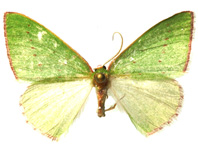Abstract
Four moth species are grouped in the genus Paromphacodes today. We add descriptions of further five new species: Paromphacodes alticola sp. nov., P. alpha sp. nov., P. onae sp. nov., P. spina sp. nov. and P. summita sp. nov. The species are confined to the parámo biome on summits of Andean volcanoes and were collected on five mountains. The case of the three first named species shows that the deep COI barcode splitting does not affect morphological diversification. The differentiation of P. alticola, P. alpha and P. onae is explained in association with orogeny of Andes and repeated periods of the local active volcanism.
References
Hall, T.A. (1999) BioEdit: a user-friendly biological sequence alignment editor and analysis program for Windows 95/98/NT. Nucleic Acids Symposium Series, 41, 95–98.
Hardwick, D.E. (1950) Preparation of slide mounts of Lepidopterous genitalia. Canadian Entomologist, 82, 231–235.
https://doi.org/10.4039/Ent82231-11Hausmann, A., Godfray, H. Ch. J., Huemer, P., Mutanen, M., Rougerie, R., Nieukerken, E.J. van, Ratmasingham, S. & Hebert, P.D.N. (2013) Genetic patterns in European Geometrid Moths Revealed by the Barcode Index Number (BIN) System. PlosOne, 8 (12), e84518, 1–11.
https://doi.org/10.1371/journal.pone.0084518Hoorn, C., Wesselingh, E.P., Steege, H.ter., Bermudez, M.A.,Mora, A., Sevink, J., Sanmartin, I., Sanchez-Meseguer, A., Anderson, C.L., Figueiredo, J.P., Jaranillo, C., Riff, D., Negri, F.R., Hooghiemstra, H., Lindberg, J., Stadler, T., Särkinen, T. & Antonelli, A. (2010) Amazonia Through Time: Andean Uplift,Climate Change, Landscape Evolution, and Biodiversity. Science, 330 (6006), 927–931.
https://doi.org/101126/science.1194585Janzen, D.H., Hallwachs, W., Harvey, D.J., Darrow, K., Rougerie, R., Hajibabaei, M., Smith, M.A., Bertrand, C., Camboa, I.C., Espinoza, B., Sullivan, J.B., Decaens, T., Herbin, D., Chavarria, L.F., Franco, R., Cambronero, H., Rios, S., Quesada, F., Pereira, G., Vargas, J., Guadamuz, A., Espinoza, R., Hernandez, J., Rios, L., Cantilano, E., Moraga, R., Moraga, C., Rios, P., Rios, M., Calero, R., Martinez, D., Briceño, D., Carmona, M., Aüu, E., Aragon, K., Umaña, C., Perez, J., Cordoba, A., Umana, P., Sihezar, G., Espinoza, O., Cano, C., Araya, E., Garcia, D., Ramirez, H., Pereira, M., Cortez, J., Pereira, M., Medina, W. & Hebert, P.D.N. (2014) What happens to the traditional taxonomy when a wellknown tropical saturniid moth fauna is DNA barcoded? Invertebrate Systematics, 26, 478–505.
https://doi.org/10.1071/IS12038Lamb, S. (2006) Devil in the Mountain — A search for the origin of Andes. Princeton University Press, Oxford, 335 pp.
Morrone, J.J. (2014) Cladistic biogeography of the Neotropical region: identifying the main events in the diversification of the terrestrial biota. Cladistics, 30, 202–214.
Õunap, E., Viidalepp, J. & Saarma, U. (2005) Phylogenetic evaluation of the taxonomic status of Timandra griseata and T. comae (Lepidoptera: Geometridae: Sterrhinae). European Journal of Entomology, 102, 607–615.
https://doi.org/10.14411/eje.2005.085Õunap, E., Viidalepp, J. & Saarma, U. (2008) Systematic position of Lythriini revised: transferred from Larentiinae to Sterrhinae (Lepidoptera, Geometridae). Zoologica Scripta, 37, 405–413.
https://doi.org/10.1111/j.1463-6409.2008.00327.xPadial, M.J., Mirales, A., De La Riva, I. & Vences, M. (2010) The integrative future of taxonomy. Frontiers in zoology, 7, 16.
https://doi.org/10.1186/1742-9994-7-16Piñas, F.R. (2006) Mariposas del Ecuador. Vol. 5a. Familias: Uraniidae, Epiplemidae, Sematuridae, Thyatiridae, Hedylidae, Geometridae: Subfamilias: Oenochrominae, Geometrinae, Sterrhinae. Piñas publ., Quito, 72 pp., 502 ill, CD-ROM.
Pitkin, L.M. (1993) Neotropical Emerald moths of the genera Nemoria, Lissochlora and Chavarriella, with particular reference to the species of Costa Rica (Lepidoptera: Geometridae, Geometrinae). Bulletin of the natural History Museum London (Entomology), 62 (2), 39–159.
Pitkin, L.M. (1996) Neotropical Emerald moths: a review of the genera (Lepidoptera: Geometridae, Geometrinae). Zoological Journal of the Linnean Society, 118, 309–440, 211 figs.
Prout, L.B. (1912) Lepidoptera Heterocera, Fam. Geometridae, subfam. Hemitheinae. In: Wytsman, P. (Ed.), Genera Insectorum, 129, pp. 1–124, 5 pls.
Prout, L.B. (1932) The American Geometridae. In: Seitz, A. (Ed.), The Macrolepidoptera of the World, 8, 1–149.
Ratnasingham, S. & Hebert, P.D.N. (2013) A DNA-Based Registry for All Animal Species: The BarcodeIndex Number (BIN) System. PLoS ONE, 8 (7), e66213.
https://doi.org/10.1371/journal.pone.0066213Schaus, W. (1929) New species of Heterocera (Lepidoptera) from Southern Brazil. Proceedings of the Entomological Society of Washington, 31, 45–61.
Sklenař, P. & Jørgensen, P.M. (2004) Distribution patterns of parámo plants in Ecuador. Journal of biogeography, 26 (4), 681–691.
http://dx.doi.org/10.1046/j1365-2699.1999.00324.xSuarez, R. & Galo Medina (2001) Vegetation structure and soil properties in Ecuadorian parámo grasslands with different histories of burning and grazing. Arctic, Antarctic and Alpine Research, 33 (2), 158–164.
Tamura, K., Stecher, G., Peterson, D., Filipski, A. & Kumar, S. (2013) MEGA6: Molecular Evolutionary Genetics Analysis Version 6.0. Molecular Biology and Evolution, 30 (12), 2725–2729. [Epub2013 Oct 16]
https://doi.org/10.1093/molbev/mst197
Thompson, J.D., Higgins, D.G. & Gibson, D.J. (1994) Clustal W: improving the sensivity of progressive multiple sequence alignment through sequence weighthing position – specific gap penalties and weight matrix choice. Nucleic Acids Research, 22, 4873–4880.
https://doi.org/10.1093/nar/22.22.4673Van Der Hammen, T. (1995) Plioceno y cuaternario del altiplano de Bogotá y Alrededores. Vol. 24. de Análisis geográficos. Editor Ministerio de Hacienda y Crédito Público. Instituto Geográfico Agustín Codazzi, Subdirección de Geografía, 142 pp.
Viidalepp, J. (2017) A morphology based key to the genera of the tribe Nemoriini (Geometridae: Geometrinae). Zootaxa, 4236 (3), 521–532.
https://doi.org/10.11646/zootaxa.4236.3.6Warren, W. (1897) New genera and species of Thyrididae, Epiplemidae and Geometridae from South and Central America and the West Indies in the Tring Museum. Novitates Zoologicae, 4, 408–507.
Warren, W. (1905) New American Thyrididae, Uraniidae, and Geometridae. Novitates Zoologicae, 12, 307–379. Avaliable from: http://www.biodiversitylibrary.org/bibliography/3882#/summary (Accessed 9 Aug. 2017)
Waugh, J. (2007) DNA barcoding in animal species: progress, potential and pitfalls. Bioessays, 29 (2), 188–197.
https://doi.org/10.1002/bies.20529

